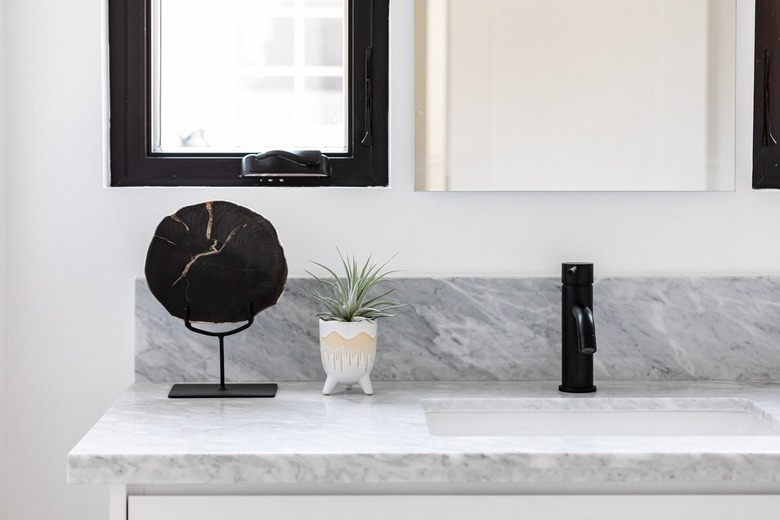How Does A Cartridge Faucet Work?
We may receive a commission on purchases made from links.
The first single-handled mixing faucet was a cartridge faucet. The story goes that Al Moen invented it after being scalded once too often. His early schematic, which is posted on the Moen website, provides an easy way to understand the working of a faucet cartridge. Modern cartridges have become more complicated and elegant than Moen's original, but they all work on the same basic principle as the one Moen invented.
The Concept Behind Cartridge Faucets
The Concept Behind Cartridge Faucets
Before the cartridge faucet, the only type available was the double-handle compression faucet. Although these are still around, they're becoming increasingly rare. One handle controls the hot water and one controls the cold, and the valves have screw threads that tighten a washer down onto the water inlet to stop the water. As these faucets age, they become increasingly unreliable as the valve rusts and becomes harder to turn, and it's easy to open one too far when you aren't paying attention, which is what happened to Moen.
Instead of two handles, a cartridge faucet has a single handle connected to a valve housing with inlets for both the hot and cold water. Inside the housing, the cartridge, which is connected to the handle, blocks water from both inlets when the faucet is off, but it has strategically placed holes that allow both hot and cold water to flow when you turn it on. The holes are engineered in such a way that rotating the handle in one direction allows hot water to flow and rotating it in the other allows cold water, so you can control both flow rate and water temperature.
It's All About the Rubber
It's All About the Rubber
The earliest cartridges were made of metal, while contemporary ones are mostly plastic, and neither of these materials can form a water seal against the valve seat, where the water inlets are located, unless they are very precisely engineered. Without rubber gaskets in the valve seats and rubber O-rings around the cartridge, there would be nothing to prevent water from continuously spraying from the spout and the faucet handle.
When a cartridge faucet leaks from the spout or the handle, it's rarely due to the cartridge, but to these rubber gaskets and O-rings. That makes fixing leaks very simple. All you usually have to do is disassemble the faucet — a straightforward task — remove the cartridge and replace the O-rings around it as well as the gaskets in the water inlets, if there are any. Some faucet cartridges and valve seats are manufactured with such precision that they don't need gaskets in the valve seats.
Identifying a Cartridge Faucet
Identifying a Cartridge Faucet
To begin with, if yours is a Moen faucet, it's a cartridge faucet, because that's the only type the company makes. Other manufacturers, notably Delta, use ball valves in their faucets, and these faucets tend to have a dome-shaped handle to accommodate the ball. Still, other faucets have ceramic disk valves, but if you read the description of this type of valve on the American Standard website, you'll see that it's just a very precise type of cartridge.
Double-handle faucets can also have cartridge valves, and these are easy to identify. Whereas you can turn a conventional compression faucet handle a full 360 degrees, and you usually have to rotate it several times to turn the water all the way on, a handle with a cartridge valve only turns through 90 degrees.
